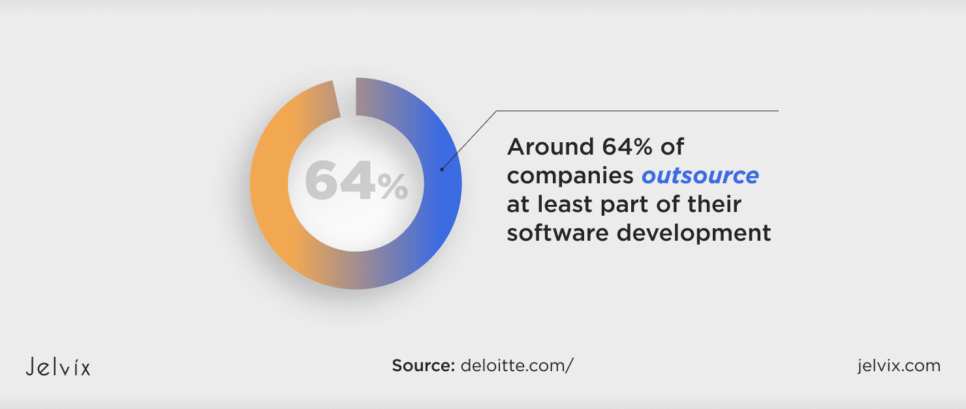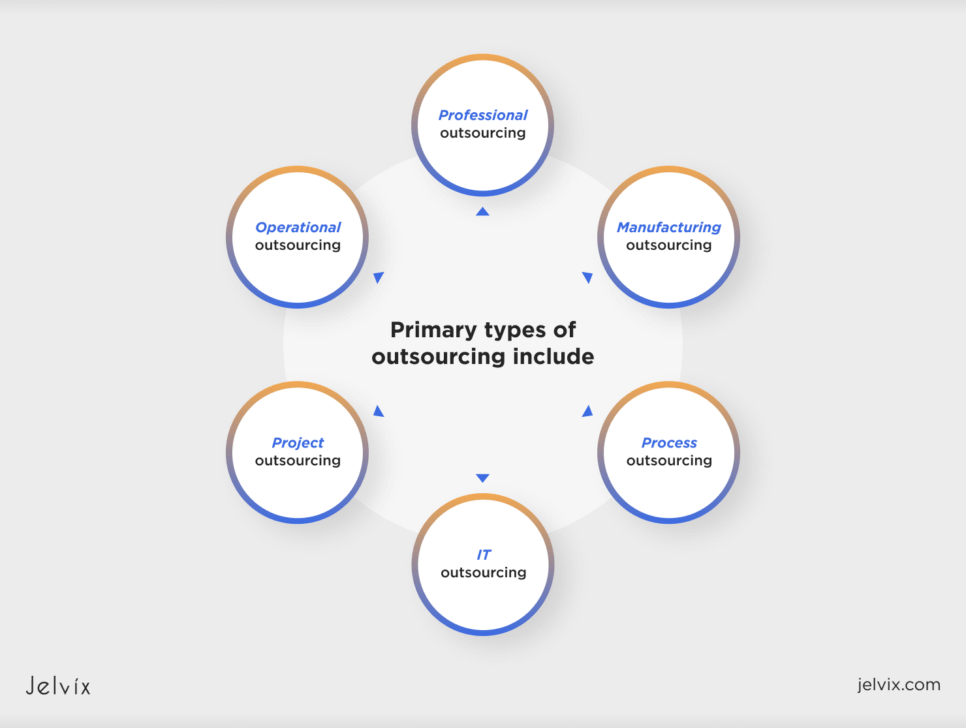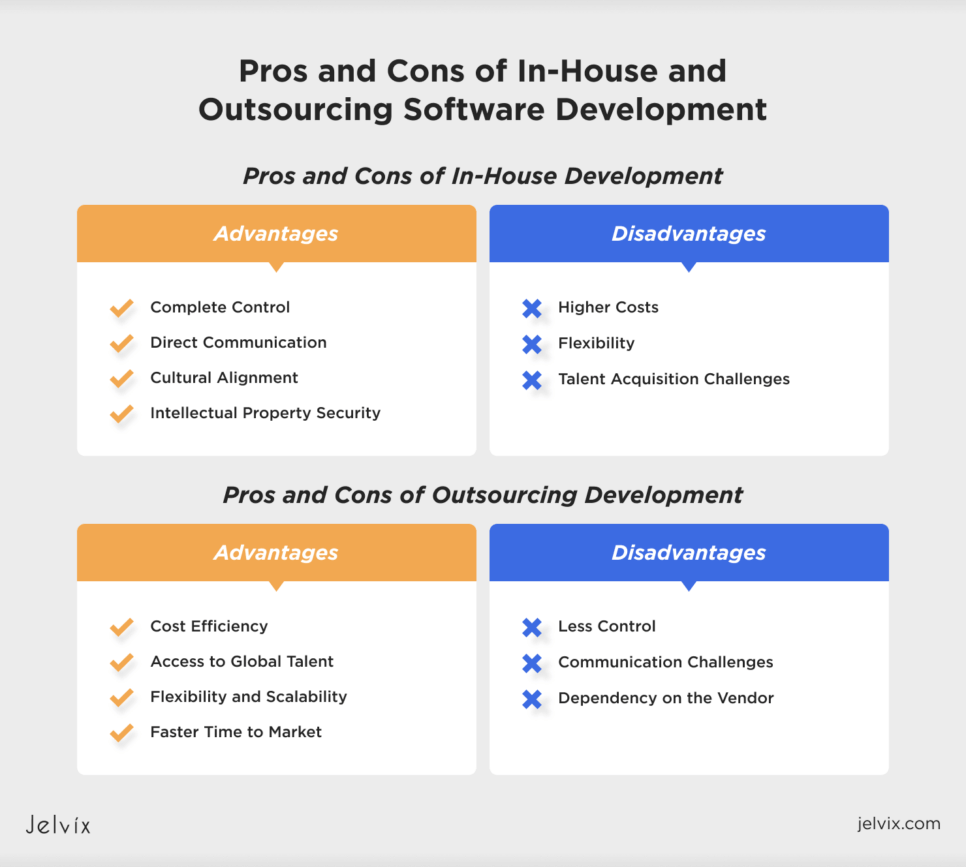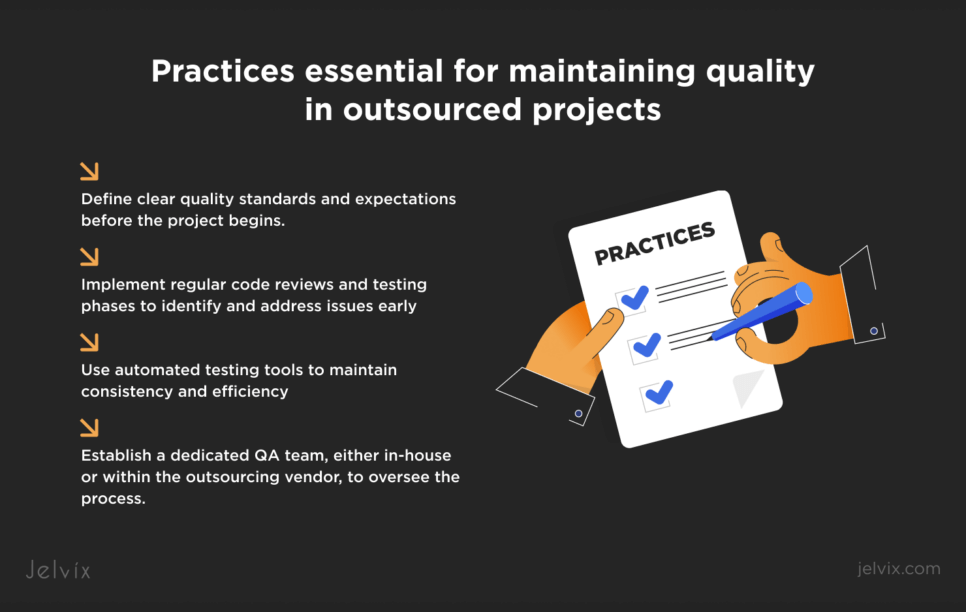Companies can either conduct in-house software development or outsource it to another company. Both choices have their advantages and disadvantages.
Software development outsourcing has become a popular choice for many companies worldwide. According to Deloitte’s Global Outsourcing Survey, around 64% of companies outsource at least part of their software development. This tendency is increasing due to its ability to reduce expenses, acquire specialized skills, and enable businesses to concentrate on their primary functions.
Knowing the pros and cons of in-house development versus outsourcing can help a company make wiser decisions regarding the creation of a software application. Let’s consider why many businesses choose outsourcing software development and how they can benefit from it in more detail.
What Is In-House Software Development?
In-house software development refers to the process of using employees to create and manage software applications. This approach allows companies to maintain full control over the development process, ensuring that the software aligns perfectly with their needs and goals.
In house development is characterized by:
- Complete Control: Companies oversee the project from start to finish, allowing quick changes and alignment with exact requirements.
- Direct Communication: Team members work closely, enhancing collaboration and problem-solving.
- Cultural Alignment: In-house teams understand the company’s values and goals, leading to better motivation and quality of work.
- Intellectual Property: Knowledge and technology remain within the company, protecting proprietary information.
Many successful companies utilize in-house development to maintain their competitive edge. For example:
- Google: Uses in-house development for its search engine algorithms and Android OS.
- Facebook: Develops software in-house to ensure user privacy and security.
- Tesla: Integrates software with its hardware for a superior user experience in its electric vehicles.
In-house can be very effective for companies targeting solutions tailored to meet specific needs and desiring to maintain control over projects. Innovating rapidly, companies can be sure their software is perfectly aligned with the business. Quick changes and direct communication inside the team can result in fixing problems more efficiently and achieving better results generally. This method mainly benefits companies focused on high-quality work and those that show their values and objectives.
What is Outsourcing?
Outsourcing is when a company hires an external organization to handle specific tasks or services instead of using its internal resources. When companies outsource software development, they utilize the skills of external teams to build and oversee their software applications. This approach enables companies to concentrate on their primary tasks while taking advantage of the expertise and resources of the external development team.
Primary types of outsourcing include:
- Operational outsourcing;
- Professional outsourcing;
- Project outsourcing;
- Process outsourcing;
- IT outsourcing;
- Manufacturing outsourcing.
Big companies have efficiently utilized outsourcing:
- Slack: To accelerate the development of its platform, Slack outsourced the initial development to a design firm called MetaLab. This decision helped Slack refine its product quickly and launch successfully.
- WhatsApp: WhatsApp, before being acquired by Facebook, outsourced the development of the app to an external team. This helped in keeping costs low while focusing on growth and user experience.
- Skype: Skype outsourced its software development to a team in Estonia. This approach enabled Skype to access top talent and build a robust platform that gained worldwide popularity.
Outsourced software development is a strategic step that a company can take. This focuses the company’s attention on other core business areas through leveraging the expertise of an outsourced development team.
Comparative Analysis of In-House vs. Outsourcing Software Development
The decision on in-house vs outsourcing software development can impact costs, control, access to talent, communication, and time to market.
Cost Analysis
In-house software development involves significant costs, including:
- salaries;
- benefits;
- training;
- infrastructure.
For example, full-time developers have competitive salaries and benefits in themselves. Besides, a company has to invest in continuous training so that the team is always up-to-date regarding the latest technologies. There are also infrastructure costs for setting up and maintaining hardware, software, and office space.
Outsourcing can initially appear cheaper as it eliminates many of the overhead costs associated with in-house teams. However, it involves service fees paid to the outsourcing vendors. There can also be hidden costs such as management and communication overhead, potential rework due to quality issues, and expenses related to travel and legal matters.
Control and Flexibility
In-house teams provide a high level of control over the development process. Companies can directly manage their employees, ensuring development aligns closely with their goals and standards. Flexibility can be limited due to fixed team sizes and slower scalability.
Outsourcing provides enhanced flexibility, allowing companies to adjust their team sizes according to project needs without the burden of long-term commitments. Nevertheless, this advantage often results in diminished control over the daily operations of the development team.
Talent and Expertise
Employing in-house means a business can set up a department that understands deeply its requirements for products and services. Yet this can present difficulties. You will find top talent, but retaining it is no easy task. In addition to the lack of access to various technologies and methodologies, an in-house team relies on different aspects outside.
Outsourcing opens a broader range of talent resources, which the company can draw upon in various ways, using particular types of expertise and specialized skills normally not available in-house. Vendors in outsourcing generally bring diverse experiences to bear and work with several projects simultaneously from varied industries; hence, they could devise newer and more innovative solutions.
Communication and Collaboration
Working with internal teams essentially means a direct, immediate way of communicating, which often translates into more effective collaboration and quicker resolution of issues. On the other hand communication between outsourced groups can be more difficult because of time differences, language barriers, or cultural styles. This can lead to misunderstandings and delays in work.
Time to Market
Developing software in-house can be slower initially due to the time required to hire and train the team. However, once the team is established, direct control and collaboration can lead to efficient development cycles.
Outsourcing can accelerate the time to market by allowing companies to utilize the established processes and expertise of external vendors. These outsourced teams can begin working on the project almost immediately, thereby minimizing the initial setup time.
Choosing between in house software development vs outsourcing development depends on various factors, including cost, control, access to talent, communication, and time to market. Each option has advantages and challenges.
Pros and Cons of In-House and Outsourcing Software Development
Pros and Cons of In-House Development
Advantages of in-house development:
- Complete Control: Companies maintain full control over the development process, allowing quick adjustments and direct oversight of project progress.
- Direct Communication: Team members work closely together, enhancing collaboration and speeding up problem-solving.
- Cultural Alignment: In-house teams are aligned with the company’s values and goals, leading to better motivation and quality of work.
- Intellectual Property Security: All knowledge and technology developed remain within the company, protecting intellectual property and proprietary information.
Disadvantages of in-house development:
- Higher Costs: In-house development can be expensive due to salaries, benefits, training, and infrastructure costs.
- Flexibility: Scaling the team up or down based on project needs can take time and effort. This can be a significant drawback in rapidly changing markets.
- Talent Acquisition Challenges: Finding and retaining top talent can be difficult and expensive. The in-house team might also have limited exposure to diverse technologies and methodologies.
Pros and Cons of Outsourcing Development
Advantages to outsourced project work can include:
- Cost Efficiency: Companies save an average of $87,012 per year by outsourcing.
- Access to Global Talent: Outsourcing enables businesses to gain access to specialized talents and experience from around the world that would otherwise be unavailable internally.
- Flexibility and Scalability: Outsourcing allows you to scale teams up or down based on project requirements, without long-term commitments.
- Faster Time to Market: Outsourcing can speed up the time to market by leveraging the expertise and established processes of external vendors. Outsourced providers can be more efficient than internal employees because they often have specialized skills and experience.
Cons of outsourcing development:
- Less Control. Companies have less oversight of the outsourced development team’s daily activities.
- Communication Challenges. Time zone differences, language barriers, and cultural differences can lead to communication issues, causing misunderstandings and delays.
- Quality Control Issues. Maintaining work quality is harder with an external team. Companies need strict quality control measures and regular project monitoring.
- Dependency on the Vendor. Relying heavily on an external team can create dependency. Problems arise if the vendor fails to deliver or the partnership ends abruptly.
There are both good points and bad to developing software in-house or outsourcing it. In-house dev offers the maximum control and direct communication line but is more expensive and difficult to find the talent. When outsourcing, businesses save on costs and get access to worldwide talent. Companies can be flexible while delegating tasks to external experts. However, outsourcing also carries problems in communication and loss of control. Understanding these pros and cons can help companies make informed decisions.
When To Choose an In-House Option
In-house development works best where projects are key to a company’s core competencies or long-term strategy. Most of these projects would call for tight control, customization, and direct oversight to ensure they precisely serve the company’s goals and vision.
Proprietary technology and sensitive data should exist within projects that have to be processed in-house. This approach will help the company retain full control over its intellectual property and sensitive information. By keeping such projects in-house, the risk of leakage and unauthorized access can be prevented to a large extent.
In-house development is more fitting for projects that demand good knowledge of inner workflows inside a company and closer collaboration with different departments. If there’s a need to discuss a project frequently and with details, having the team on-site will aid in better coordination and thus lead to solving problems more quickly. Proximity helps develop good relations and understanding between team members, therefore leading to cohesion and efficiency in executing projects carried out by a team.
When To Choose Outsourcing
Outsourcing is particularly suitable for projects that require highly specialized expertise. For example, the development of AI algorithms of high complexity or integration of the latest technologies may require special competence not currently available within your team. By outsourcing, you open yourself up to a global talent market and can onboard experts possessing the exact skills that your project requires. You also ensure your project uses the most up-to-date industry practices and innovations.
Outsourcing can save considerable costs in cases where budgetary constraints are important. Companies will save on all the expensive activities involved in recruiting, training, and maintaining an in-house team. It makes the cost of software development more predictable, as companies usually pay for certain services provided and exclude overhead costs connected with full-time salaries and benefits. Cost efficiency could be critical to a startup or when looking at optimizing budgets without an impact on the quality of software developed.
Outsourcing provides the flexibility to scale development resources quickly in response to rapid growth or fluctuating project demands. Outsourcing provides the flexibility to scale development resources quickly in response to rapid growth or fluctuating project demands.
Outsourcing can help mitigate risks associated with software development. External vendors typically have established processes and expertise to manage potential issues effectively. This includes everything from compliance with industry standards to handling security concerns and project management challenges. By outsourcing, companies can reduce the risks involved in complex projects and ensure more reliable outcomes
Managing Outsourced Software Development Projects
Choosing the right outsourcing partner is crucial for the success of your project.
- Start by identifying your specific needs and look for vendors with proven experience.
- Check their portfolio and client testimonials to gauge their reliability and expertise. Consider vendors who have worked on similar projects and can provide case studies.
- Evaluate their technical capabilities, communication skills, and cultural compatibility.
A thorough due diligence process, including interviews and reference checks, will help you make an informed decision.
As mentioned earlier, one of the biggest drawbacks of outsourcing is the lack of controlled and regular communication. The good news is that this can be solved with some managing hacks:
- Set up regular check-ins and updates using video chats, emails, or messaging applications.
- Use collaboration platforms such as Slack or Microsoft Teams to improve real-time communication.
- Identify project goals, timelines, and deliverables from the start.
- Encourage open communication and provide prompt feedback to ensure that everyone is on the same page.
- Set up a comprehensive communication plan to prevent misunderstandings and keep the project on schedule.
Ensuring the quality of outsourced work requires robust quality assurance (QA) practices.
- Define clear quality standards and expectations before the project begins.
- Implement regular code reviews and testing phases to identify and address issues early.
- Use automated testing tools to maintain consistency and efficiency.
- Establish a dedicated QA team, either in-house or within the outsourcing vendor, to oversee the process.
Continuous monitoring and feedback loops help maintain high-quality standards throughout the project.
Finally, utilizing project management tools can significantly enhance the management of outsourced projects. Tools like Jira, Trello, and Asana help track progress, assign tasks, and manage deadlines. These platforms provide a transparent view of the project’s status and facilitate better coordination among team members. Features like task dependencies, time tracking, and reporting dashboards allow efficient project oversight.
Learn more about the main stages of the product development lifecycle to build a sustainable product.
Conclusion
Selecting the right team tailored to your project’s needs ensures smooth workflow and timely delivery. By focusing on these key areas, companies can navigate the complexities of software development and achieve successful project outcomes.
For more details or personalized advice on managing your software development outsourcing, feel free to reach out to us. At Jelvix, we specialize in optimizing software development processes to ensure your success. Contact us today to start maximizing the results of your projects!
FAQ
How do I determine the right budget for software development?
Determining the right budget for software development involves analyzing the project’s scope, complexity, and desired features. For in-house development, consider ahigher initial investment required for salaries, benefits, and infrastructure. On the other hand, outsourcing might offer more flexible and scalable pricing models, allowing you to adjust the budget based on specific project needs and vendor agreements.
What are the common pitfalls in outsourcing software development?
Common pitfalls in outsourcing software development include choosing the wrong vendor, miscommunication, lack of control over the project, and quality assurance issues. To mitigate these risks perform thorough research and due diligence when selecting a vendor. Establishing clear communication channels, setting detailed contracts, and using project management tools to track progress can also help ensure a successful outsourcing experience.
How can I ensure the security of my project when outsourcing?
Ensuring the security of your project when outsourcing involves selecting a reputable vendor with strong security protocols. Sign non-disclosure agreements (NDAs) to protect sensitive information, and implement robust data encryption methods to safeguard data. Regular security audits and compliance with industry standards are also essential to protect your project from potential security breaches.
What are the latest trends in software development outsourcing?
The latest trends in software development outsourcing include the increased use of artificial intelligence (AI) and machine learning (ML) for project management. There is also a growing demand for cybersecurity expertise due to the increasing importance of data protection. Additionally, the adoption of agile and DevOps methodologies has become more prevalent, improving collaboration and productivity. Nearshoring is also gaining popularity as it reduces time zones and cultural differences, facilitating better communication and project management.
What are the advantages of hybrid models in software development?
Hybrid models combine the benefits of both in-house and outsourcing by maintaining a core team in-house while outsourcing specific tasks to external vendors. This approach offers cost savings, flexibility, and access to specialized skills while retaining control over critical aspects of the project. By leveraging the strengths of both models, companies can achieve a balanced and efficient development process that meets their unique needs.
Need a qualified team of developers?
Own the dedicated development team of professionals exclusively for your project.














